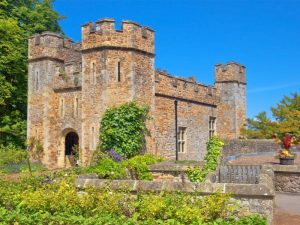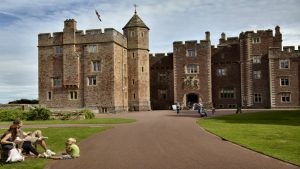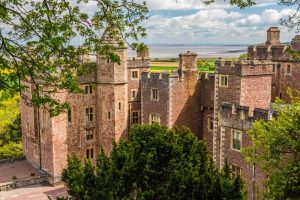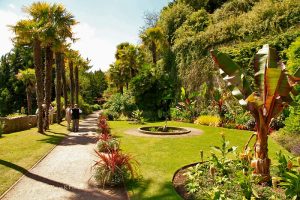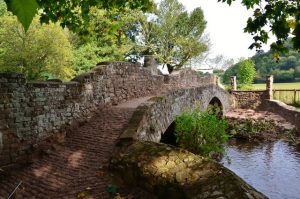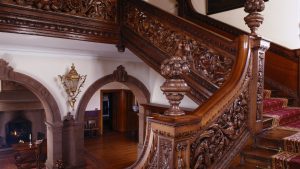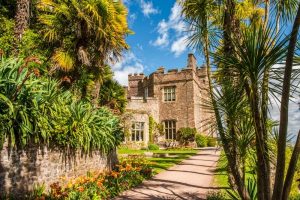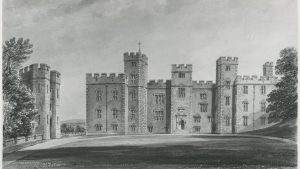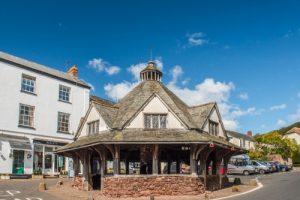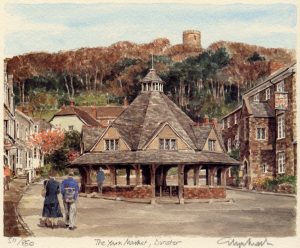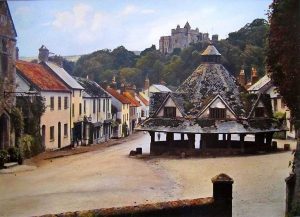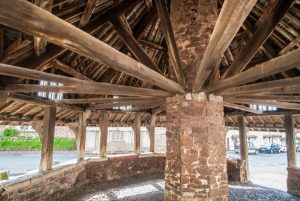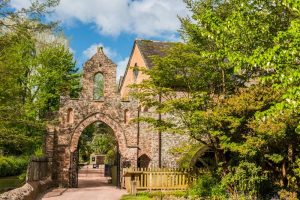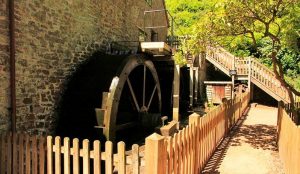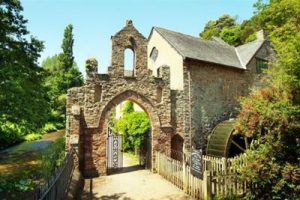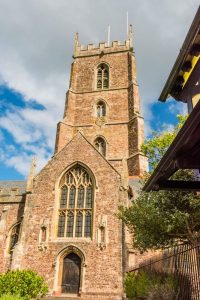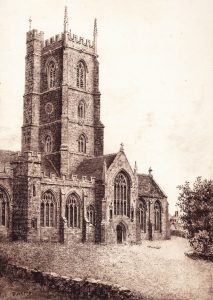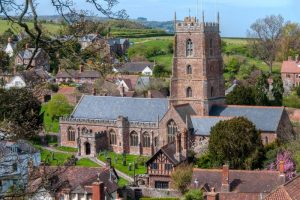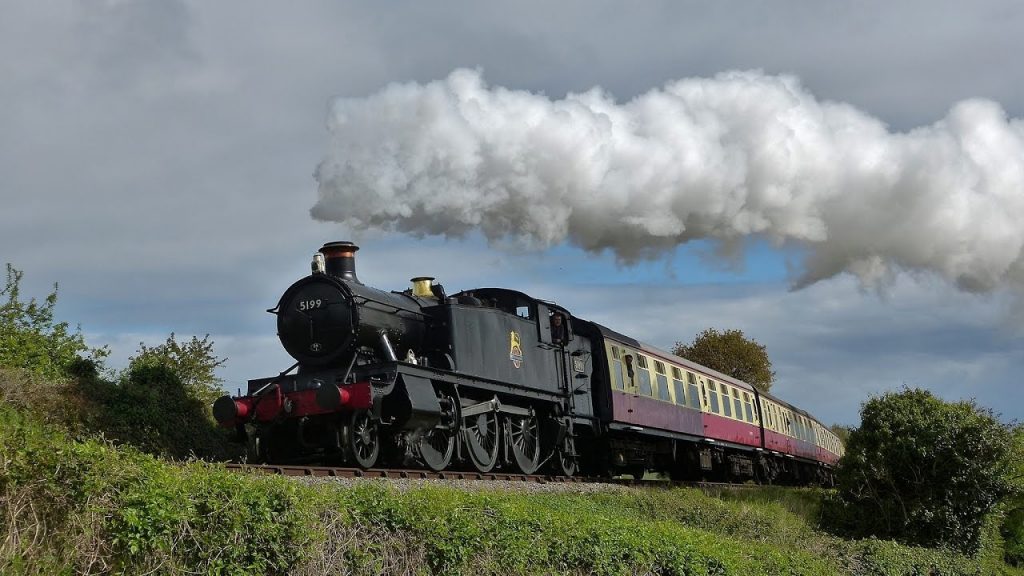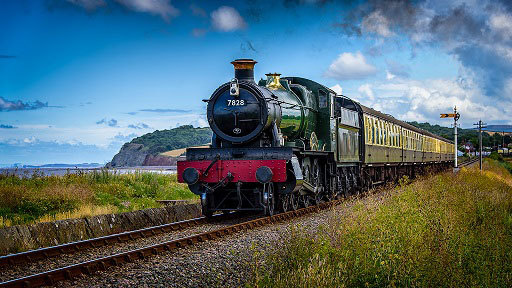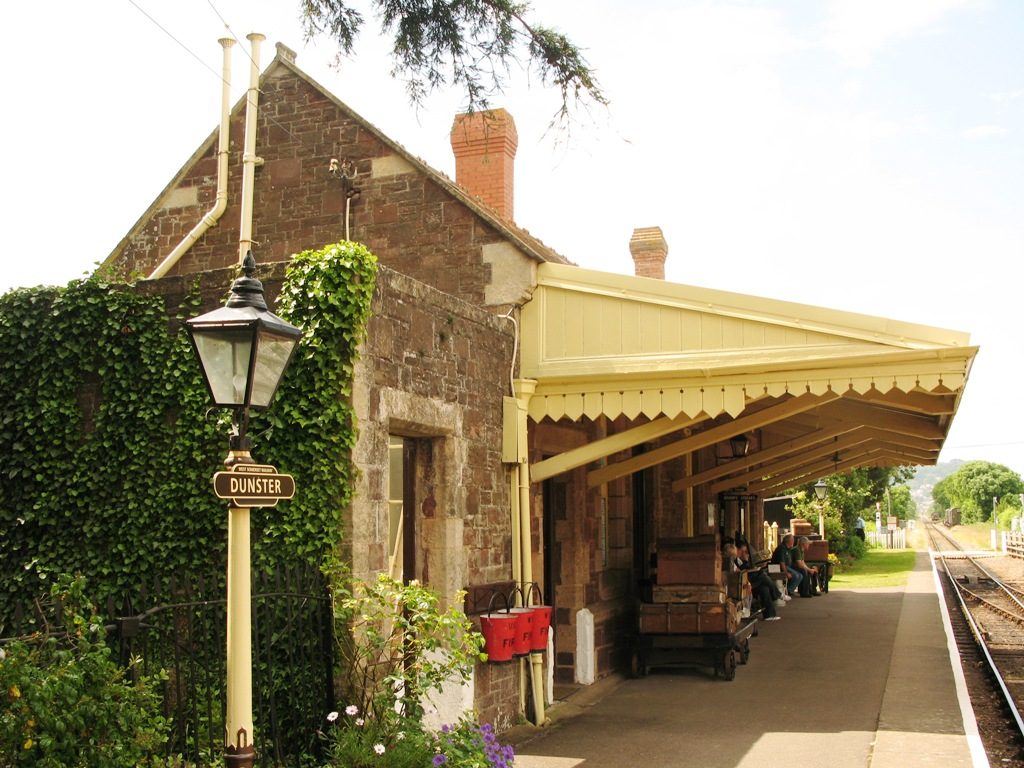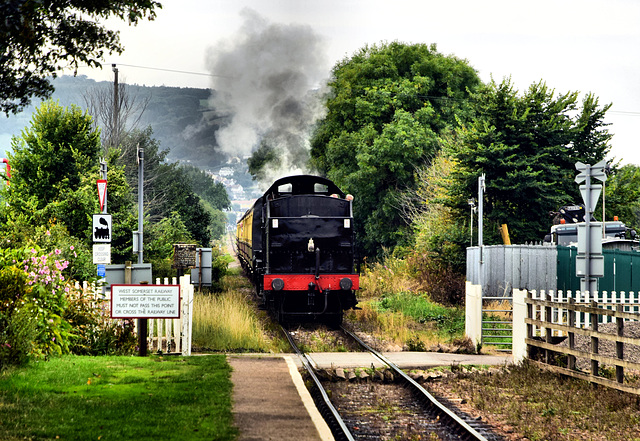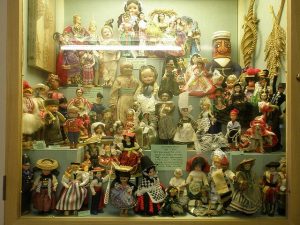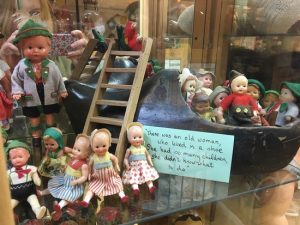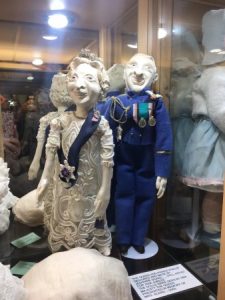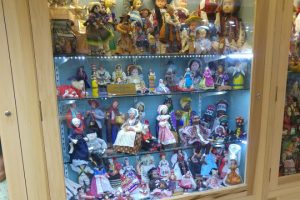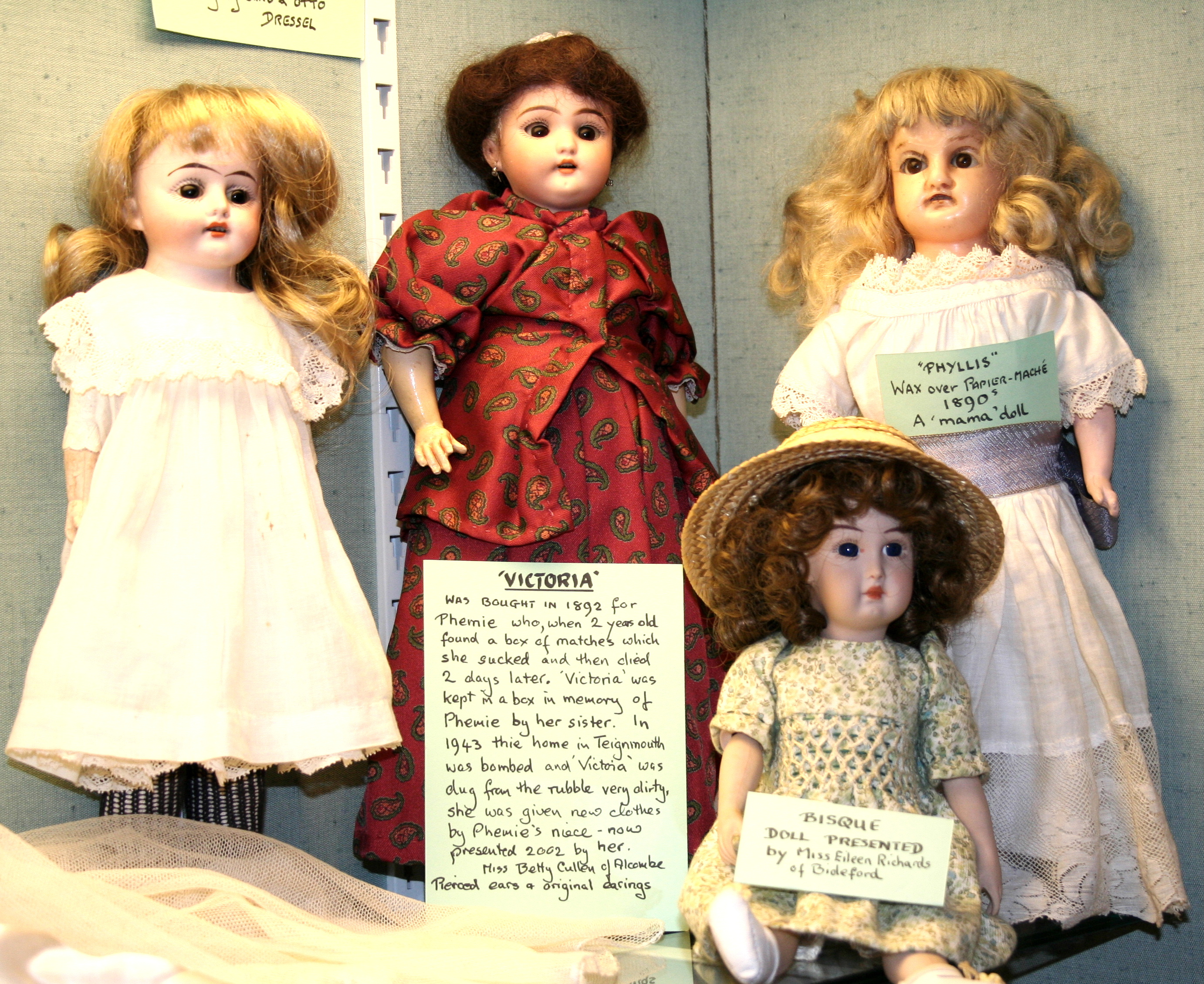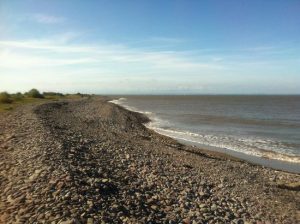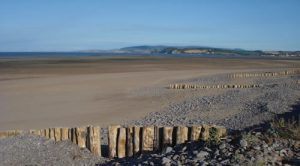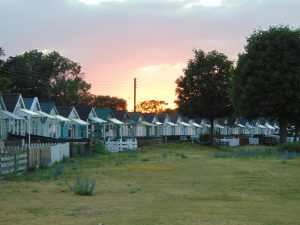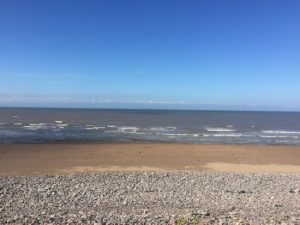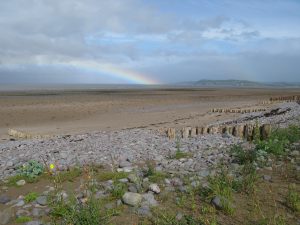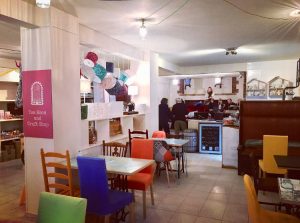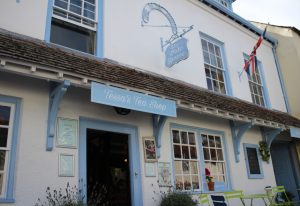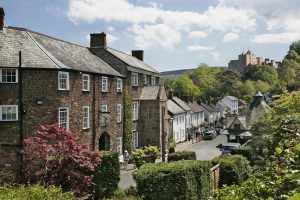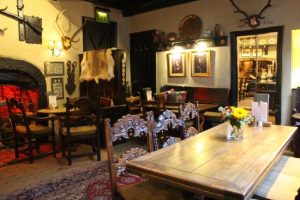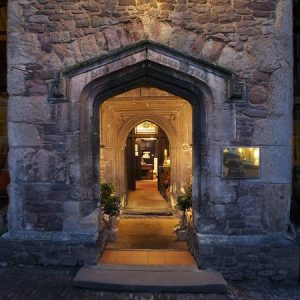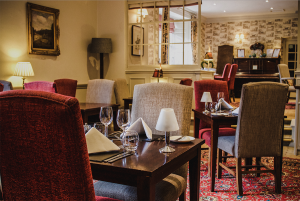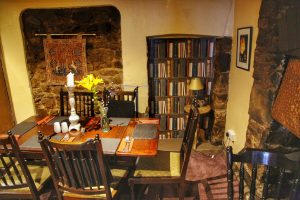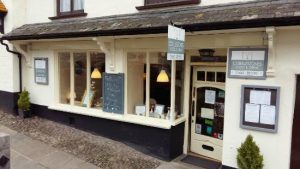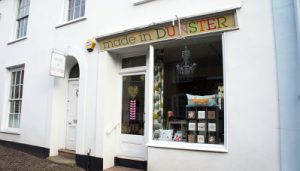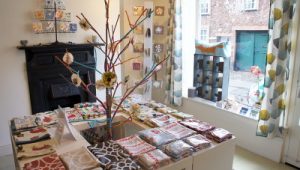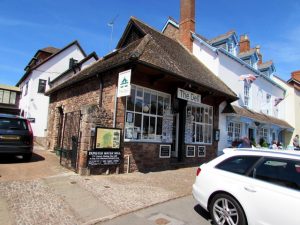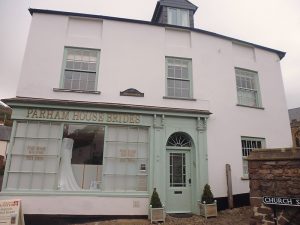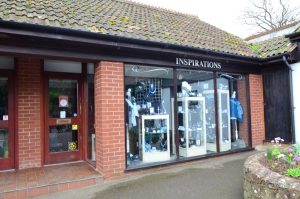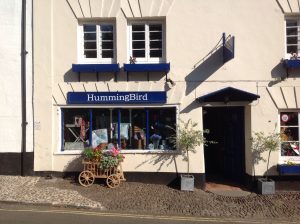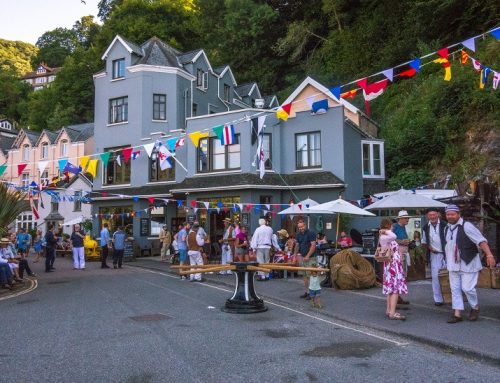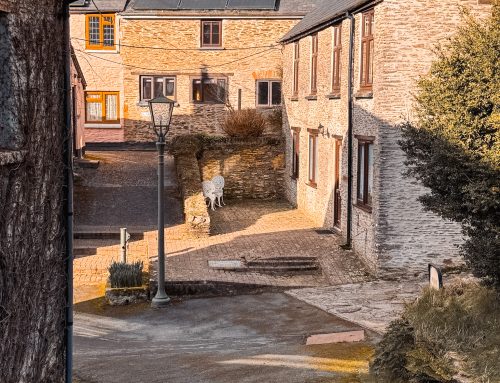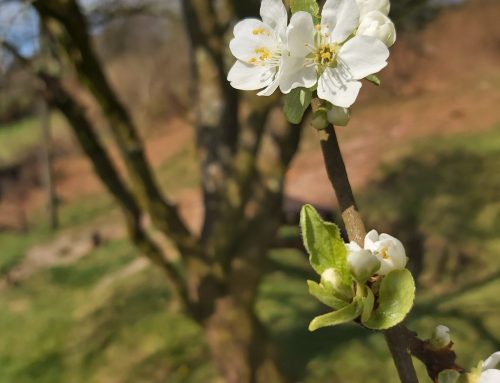Dunster is one of the most popular places on Exmoor for visitors. It is a medieval village with an ancient castle, priory, dovecote, yarn market, inns, packhorse bridge and a mill. Since the decline of the woollen industry in the eighteenth century the village has been locked in a time warp. Dunster Castle, once the home of the Luttrell family, is now owned by the National Trust. There is a plethora of tea shops and gifts shops and several excellent restaurants and places to stay. The National Park Centre here provides information on the whole area and there is a large car park on the edge of the village. With over 200 listed buildings Dunster is preserved so that generations to come can enjoy the historic qualities of this unique village. Situated in the sweeping hills of Exmoor National park Dunster provides the ideal base for your holiday in the South West of England.
History of Dunster
The village grew up around Dunster Castle which was built on the Tor by the Norman warrior William I de Moyon (d. post 1090) shortly after the Norman Conquest of 1066. The Castle is mentioned in the Domesday Book of 1086. From that time it was the caput of the Feudal barony of Dunster. The Castle was remodelled on several occasions by the Luttrell family who were lords of the manor from the 14th to 20th centuries. The benedictine Dunster Priory was established in about 1100. The Priory Church of St George, dovecote and tithe barn are all relics from the Priory.
A harbour used to exist, known as Dunster Haven, at the mouth of the River Avill, yet today the coast has receeded about 0.5 miles (0.80 km) from the village and no sign of the harbour can be seen on the low lying marshes between the village and the coast. Dunster has a range of heritage sites and cultural attractions which combine with the castle to make it a popular tourist destination with many visitors arriving on the West Somerset Railway, a heritage railway running from Minehad to Bishops Lydeard.
Dunster had become a centre for woollen and clothing production by the 13th century, with the market dating back to at least 1222, and a particular kind of kersey or broadcloth became known as ‘Dunsters’. The prosperity of Dunster was based on the wool trade, with profits helping to pay for the construction of the tower of the Priory Church of St George and provide other amenities. The 15th century Gallox Bridge was one of the main routes over the River Avill on the southern outskirts. The market was held in “The Shambles” however these shops were demolished in 1825 and now only the Yarn Market remains.
Dunster was the birthplace of the song “All Things Bright and Beautiful” when Cecil Alexander was staying with Mary Martin, the daughter of one of the owners of Martins Bank. The nearby hill, Grabbist, was originally heather-covered before its reforestation and was described as the “Purple-headed mountain”.
On the evening of 1 May each year the Minehead Hobby Horse visits Dunster and is received at the Castle. A local newspaper printed in May 1863 says “The origin professes to be in commemoration of the wreck of a vessel at Minehead in remote times, or the advent of a sort of phantom ship which entered the harbour without Captain or crew. Once the custom was encouraged, but now is much neglected, and perhaps soon will fall into desuetude.” Another conjecture about its origin is that the hobby horse was the ancient King of the May. The Hobby Horse tradition begins with the waking of the inhabitants of Minehead by the beating of a loud drum. The hobby horse dances its way about the town and on to Dunster Castle.
Annually on the third Friday in August the village hosts the well known Dunster Show where local businesses and producers come together to showcase the very best that Exmoor and West Somerset has to offer. A major part of the show is the showing of livestock especially horses, cattle and sheep. The 2019 show will be the 173rd Dunster Show.
A more recent tradition (started in 1987) is Dunster by Candlelight which takes place every year on the first Friday and Saturday in December when this remarkably preserved medieval village turns its back on the present and lights its streets with candles. To mark the beginning of the festival on Friday at 5 pm, there is the Lantern Lighting Procession that starts on the Steep and continues through the village until all the lanterns in the streets have been lit. The procession of children and their families is accompanied by colourful stilt walkers in costumes who put up the lanterns.
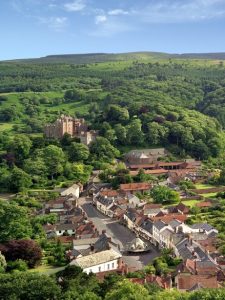
Dunster Castle
With 1,000 years of history the castle has plenty of great stories to tell. Dunster Castle has commanded this outstanding location atop the tor since the Middle Ages. It is a perfect site for a castle – visually impressive and easily defended. The castle, owned by only two families, has been transformed through the ages from fortress to family home. The last family to live here, the Luttrells, moved in in 1376 and out in 1976, and changed a medieval stronghold into a comfortable family home.
The long and eventful history of Dunster Castle starts with the de Mohuns who arrived soon after William the Conqueror became King of England in 1066. William de Mohun constructed a timber castle on the site of a Saxon hill fort as part of the pacification of Somerset. Nothing remains of the de Mohuns’ castle except the 13th century lower level gateway with its massive iron-bound oak doors. In 1139 supporters of King Stephen tried to take Dunster but failed. A 13th century Mohun, Reynald II, added a stone gateway leading to the lower ward. This is the oldest surviving part of the castle today. In the 1470s the bill for repairing the castle gateway was just £1 and it was clearly money well spent as the doors are still in good order today. The medieval castle was fortified by a stone curtain wall and bastion towers along the north side of the lower ward. One such bastion tower remains to this day, although in a semi-ruined state as the wall was demolished by Oliver Cromwell’s men in 1650 at the end of the English Civil War. The owner at that time, George Luttrell thankfully managed to persuade parliament to let him keep his family home.
In 1376 the de Mohuns sold the castle to the Luttrell family, who were responsible for most of what we see at Dunster today. They built the gatehouse in 1420, created a Jacobean mansion in 1617, defended and saved the castle during the English Civil War and updated the castle in the Victorian era. In 1680 Colonel Francis married the beautiful and wealthy Dorset heiress, Mary Tregonwell. They spent enthusiastically. One of their additions was adding the carved staircase, probably by Edward Pearce, one of the best carvers of the time. The staircase is a feast for the eyes in rich, dark wood, but at one time all this intricate carving was painted white. The panels are carved with hunting scenes that run in and out of acanthus leaves that demonstrate the wealth and power of the Luttrell family.
In 1868, another George Luttrell began an ambitious building programme at Dunster Castle. George Fownes Luttrell employed architect Anthony Salvin to redesign the castle and create a comfortable Victorian family home. Salvin had worked on other castles and country houses including Alnwick, Caernarfon and Windsor Castle. At Dunster he altered the building’s exterior, demolishing the chapel on the south front, building two new towers and adding battlements emphasising its medieval origins. A major part of Salvin’s work was the improvement of the servants’ quarters. Salvin rather ingeniously created corridors for servants to move around in as well as relocating the kitchen from the west of the castle to the new tower wing on the east. Other innovations included new bedroom suites and a bathroom with hot running water – the height of luxury. With Salvin’s remodelling, the Luttrells had a large comfortable family home, efficiently run with the help of servants. This enabled George and his wife Anne to invest heavily in the local economy and back the railway to Minehead and promote the town as a port and seaside resort.
Alexander inherited the estate in 1910 but he continued to live at Court House, East Quantoxhead. He squired both properties for 34 years till his death in 1944. The estate was liable for an enormous amount of inheritance tax. The size of the bill left his son Geoffrey little option but to sell the castle and the estate. The Luttrell family became tenants of their historic family home till 1954 when they were able to buy back the castle and grounds, this time opened to the public. When Geoffrey died in 1957 his wife remained at the castle till her death in 1974. Her son, Walter Luttrell, gave Dunster Castle to the National Trust in 1976.
21 generations of Luttrells have lived at Dunster, but the original Norman fortress here was erected by the Norman lord William de Mohun, who was granted estates at Dunster after the Battle of Hastings. The natural hill was perfect for a traditional Norman motte and bailey fortification. The first defences were simple earthworks, but in the early 12th century William’s son, also named William, added stone fortifications.
At the outbreak of the Civil War the castle was held for Parliament, but after resisting an attack, the garrison switched sides and supported the Royalist cause. Led by a Colonel Wyndham, the Dunster garrison held out for 5 months against a Parliamentary siege until finally surrendering in 1646.
Dunster, which is home to the National Collection of Arbutus, is also noted for its terraced gardens with subtropical plantings including palms and citrus specimens. Dunster Castle has original 13th-century gatehouse and fine interiors. Here you will find the ‘Dunster lemon’, a direct descendant of the first lemon grown at Dunster during the Victorian period.
As part of the 40th Anniversary of the National Trust managing Dunster Castle, an underground reservoir has been uncovered for the first time, giving visitors the rare chance to head below ground to see a piece of Victorian engineering first hand. Visitors can now venture around four and a half metres below the level of the Keep Garden lawn, which originally was the site of the upper ward of the Norman motte and bailey castle, and enjoy a new audio and light presentation.
The reservoir was established as part of a range of Victorian improvements made to Dunster Castle in the 1860s and 1870s by George Fownes Luttrell. At this time the Dunster Estate was at its most prosperous which enabled Luttrell to create an up-to date, modern dwelling within the castle, which had seen little improvement in the preceding century. The reservoir was constructed in 1870 and it originally helped supply water to the Minehead Waterworks Company and by 1897 it was helping the development of homes with running water in Minehead.
The Yarn Market
The Yarn Market was built in 1609 by George Luttrell of Dunster Castle to provide shelter for merchants during Dunster’s regular markets. Dunster was a busy centre for trading wool, with shepherds bringing wool fleeces from the high moors of Exmoor to sell at Dunster.
Dunster became a centre of a new weaving industry. Mills sprang up to create woven cloth, evolving a new type of weave that is still known as Dunster cloth – an Act of Parliament was passed in 1607 to regulate exactly how the kersey cloth type known as ‘Dunsters’ could be made.. The main reminder of these heady days is the glorious octagonal Yarn Market on the cobbled High Street. This timber-framed building acted as a trading centre for the prosperous wool merchants, and though it was rebuilt in the Jacobean period it is actually much older. Look for the hole made by a Civil War cannonball.
The Yarn Market is surrounded by picturesque 17th century cottages, and the view of the market and cottages is a favourite of travel photographers. One of the prettiest buildings on the High Street is the Luttrell Arms, dating to around 1500, and known for its hammerbeam roof.
The Yarn Market was damaged during the Civil War when Dunster Castle was under siege for 160 days. You can still see the hole made by a Civil War cannonball on one of the large oak beams. The building was restored in 1647, the date which appears on the weathervane.
Dunster Watermill
Dunster Working Watermill is a restored Grade II* listed watermill that dates to the 18th century, though there was a mill on this site as early as the Domesday Book of 1086. The mill was built in the late 17th century but extensively remodelled around 1779-1782 to form the building we see today. It closed in 1962 but was restored in 1979 and is still used to grind flour. The mill features a pair of overshot wheels to the east side, and the interior milling machinery is in full working order. The use of two overshot wheels is quite unusual. The mill site is entered through a large gatehouse with a pointed arch and wrought-iron gates. It is owned by the National Trust but operated as a tourist attraction by a private company.
The overshot wheels power the grindstones by a series of belts linked to the crown wheel. This drives the grindstones themselves and the sack lift. On the first floor is a doorway allowing corn to be lifted to the top of the mill building. The milled grain is then sifted through a winnowing machine. You can buy freshly ground wholemeal organic flour in the mill or at the Dunster Castle shop.
A Saxon mill existed in this location at least as early as 1066. Twenty years later, the Domesday Book mentions a pair of grist mills at Dunster, known as Castle Mill and Nethermylle. By 1279 the two mills returned an annual revenue of some 2 pounds 13s 4d. In 1329 Sir John de Mohun of Dunster Castle leased his two mills to Walter Rughe, one of Dunster’s burgesses, for 24 marks.
In 1405 Sir Hugh Luttrell leased both mills for a term of 60 years at a yearly rent of 10 pounds, on the condition that the tenants would handle any repairs, though Sir Hugh agreed to supply the timber for those repairs. In 1427 a third mill called Newmylle (Newmill) was built beside Nethermylle by a tenant named William Person. Within 4 years the mills were renamed as Overmylle, Nethermylle, and Newmylle.
In 1604 George Luttrell engaged in a dispute over the legality of diverting the millstream. Just a few years later in 1620 the mils were renamed yet again; the first was now called Higher Mill, while the other two mills were combined under one roof to become Lower Mill. The Higher Mill was last mentioned in 1650 though we do not know exactly when it was demolished or, indeed, where it stood. That left only the Lower Mill, with two mill wheels. A curious note in the 17th-century records suggests that the miller, one Ralph Hill, invested his profits from the mill in a set of 6 silver spoons.
In 1779 the mill was rebuilt and new milling machinery installed. This gave the mill its present appearance. The mill was leased to John Harvey and the Harvey family continued to run it until 1875 when their family business was taken over by Thomas Evered. It passed in time to James Phillips, but Phillips had another mill at Minehead and, as Sir Maxwell Lyte remarked in his diary for 1909, ‘The wheels often stand idle nowadays…’
Sometime in the late 19th or early 20th century the mill was adapted to allow one waterwheel to drive two sets of grindstones. Only one set of stones was used for producing wheat flour. The old wooden machinery was replaced with cast iron, with the exception of the waterwheels.
In 1930 the mill was run by the Cockrem brothers who ground flour just once a week and baked fresh rolls for delivery to the Castle and throughout the village. It became a popular subject for artists, drawn by its romantic situation on the millstream and the covering of ivy that clung to the mill exterior. So popular did the mill become that the castle charged painters 2/6d per day for sketching or painting.
The mill was restored in 1939 and continued to grind grain for animal feed until 1962. The National Trust restored it to full working order in 1979 and it opened to the public in 1980. It can be reached through Dunster village by following Mill Lane, or from the Dunster Castle riverside walk. The walk is very well signposted from within the castle grounds.
St George’s Church
Dunster Priory was established as a Benedictine monastery around 1100. The first church in Dunster was built by William de Mohun who gave the church and the tithes of several manors and two fisheries, to the Benedictine Abbey at Bath. The priory, which was situated just north of the church, became a cell of the abbey.The church was shared for worship by the monks and the parishioners, however this led to several conflicts between them. One outcome was the carved rood screen which divided the church in two with the parish using the west chancel and the monks the east. The priory church is now in parochial use as the Priory Church of St George which still contains 12th and 13th century work, although most of the current building is from the 15th century. It has been designated as a Grade I listed building. In 1332 it became more separated from the Abbey at Bath and became a priory in its own right.
The Priory Church of St George is predominantly 15th century with evidence of 12th- and 13th century work. It has been designated as a Grade I listed building. The church was started by William de Moyon during the 11th century. The tower was built by Jon Marys of Stogursey who received a contract from the parish in 1442. He was paid 13s 4d (approx. 67p) for each foot in height and £1 for the pinnacles. The work was completed in three years. Aisles were added in 1504.
Gallox Bridge
On the outskirts of Dunster stands a ruined medieval market cross, and if you wander past pretty thatched cottages to the river you’ll find Gallox Bridge, a medieval packhorse bridge that has been in use for over 500 years. The bridge was probably built in the 15th century and was used by shepherds bringing wool fleeces from the high moors of Exmoor to the busy wool market in Dunster. The name ‘Gallox’ comes from ‘gallows’, a reference to a place of public execution on a hill outside the village, where the lords of Dunster Castle would hang thieves.
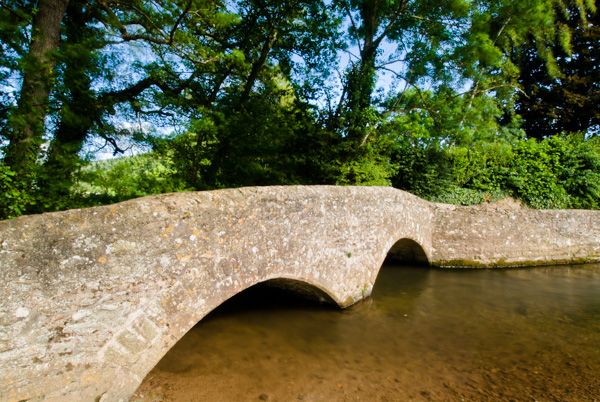
West Somerset Railway – Dunster Station
West Somerset Railway is the longest heritage railway in England at 22.75 miles and operates heritage steam and diesel trains. It travels through beautiful countryside passing the Quantock Hills and Exmoor, and runs close to the coast at Helwell Bay. There are 10 stops, all of which have fascinating sites to explore.
The line opened in 1862 between Taunton and Watchet and was extended to Minehead in 1874. Initially a single track, improvements were needed in the first half of the twentieth century to accommodate the significant number of tourists that wished to travel to the Somerset coast. The line was closed by British Rail in 1971 and reopened in 1976 as a heritage line.
Dunster station has been serving the village since 1874 and is around 20 minutes walk from the High Street. It is situated in what is now Dunster Marsh although the area was once known as Rotten Row when it was adjacent to the long lost harbour. It is a five minute walk to Dunster Beach and along the way walkers may be able to make out the sunken area of land which marks the site of the Medieval Port of Dunster.
The station building may well look familiar to those with a model railway as Hornby produced a 4mm scale model for many years. Opposite it is the goods shed and yard which is reputed to be haunted!
From Dunster, passengers can either travel into Minehead or take longer trips to destinations such as Washford (for Cleeve Abbey and Torre Cider Farm), historic Watchet or the southern terminus at Bishops Lydeard, which is four miles by bus from Taunton.
The WSR runs the “Dunster Castle Express” train each Wednesday and Saturday from Bishops Lydeard (starts in April and ends in October) and special trains each December for the Dunster by Candlelight event. In addition special bus links operate between the station and Dunster Steep during the Country Fair and Dunster Show.
Memorial Hall
Since 1921, Dunster Memorial Hall has been at the centre of village life. Given to the village by Alexander Luttrell for meetings, activities, parties, & events in remembrance of those from the village who served and those who lost their lives in the First World War. It was the prime meeting place for villagers and it has served the community well for many years. It now houses the new Dunster Museum, a large Doll Collection (the largest outside the V&A), a Snooker Room and other community facilites.
Dunster Museum
Discover the amazing story of this beautiful village and travel through time from its foundation 3,000 years ago to the present at Dunster’s new Museum.
See some fantastic finds that the Museum has collected, such as an intact Medieval tile dug up when Robin was doing some double digging in his veg patch in Park Street and the spectacular Roman pots Phil found at the Beach!
The Hardwick Gallery was recently renamed by Tim Taylor from Time Team Dig Village, at the launch of their Interim Report on their archaeological investigations into Dunster, after Martin Harborne. Martin was the driving force behind the new mezzanine for the doll collection which enabled us to build a new Museum documenting the history of Dunster.
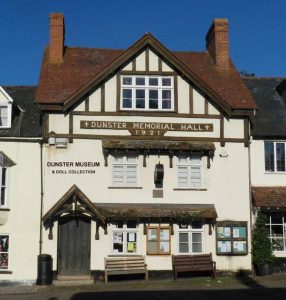
Doll Collection
The unique doll collection, the largest outside the V&A, was started by Mrs Mollie Hardwick in her Dunster cottage in 1957. Failing health had prevented her from getting about or travelling abroad, so the world and its dolls came to her as relatives and friends collected them on their travels.
The Dolls Collection opened in 1971 and since then many more dolls have been added. There are now thousands of dolls spanning different time eras, cultures and manufacturers. There are Artists’ and Fashion Dolls and a unique collection of 20 “Sasha” Dolls in 1913 period dress, and the Bristol Red Cross Dolls. The collection is always growing so there are likely to be many new additions and faces if you have been before!
Dunster Beach
Dunster Beach, which includes the mouth of the River Avill, is located half a mile from the village, and used to have a significant harbour, known as Dunster Haven, which was used for the export of wool from Saxon times; however, it was last used in the 17th century and has now disappeared, as new land was laid down among the dykes, meadows and marshes near the shore. During the Second World War, considerable defences were built along the coast as a part of British anti-invasion preparations, though the north coast of Somerset was an unlikely invasion site. Some of the structures remain to this day. Most notable are the pillboxes on the foreshore of Dunster Beach. These are strong buildings made from pebbles taken from the beach and bonded together with concrete. From these, soldiers could have held their ground if the Germans had ever invaded. The beach site has a number of privately owned beach huts (or chalets as some owners call them) along with a small shop, a tennis court and a putting green. The chalets, measuring 18 by 14 feet (5.5 by 4.3 m), can be let out for holidays; some owners live in them all the year round.
Shops
There are a wide variety of shops in Dunster, ranging from local produce to shops shipping all over the UK!
Contemporary gifts and homewares made in the workshop next door, plus a select range of local artists’ work and preloved items.
Bespoke and wholesale orders welcome!
The Deli
Delicious deli, selling the very best local artisan food, over 100 local beers and ciders, as well as catering for all your essential grocery needs.
Luxury decorations and much more.
Designer wedding dresses in an idyllic setting. Showcasing award winning designers with a specialist and welcoming service from designer Susan Hinckley.
Stylish jewellery, handbags, summer sandals, accessories, soaps, fragrances and a variety of gifts.
Chatelaine Antiques
Chatelaine is an interesting, well stocked antiques and vintage collectables shop. Reasonable prices and no reproductions!
If you love jewellery, crystals, faeries and beautiful gifts then look no further! Enjoy the magical surroundings of the shop & find something special.
A gift shop brimming with lovely things including Lily-Flame Candles, slippers, bags, umbrellas, hats, glass balloons, christmas decorations and so much more!
Crooked Window Gallery
Locally handmade fine jewellery
Specialise in a large range of unusual homeware and various selections of travel accessories, in particular leather and sheepskin.
A unique independent business providing its own range of clothing alongside a number of exceptional brands. Friendly advice from style and colour-trained staff.
A superb selection of original paintings and limited edition bronze sculpture.
Stock a carefully selected range of gorgeous home accessories, unique gifts, cards, toys and quirky vintage finds. Proud stockists of the truly amazing Annie Sloan chalk paint, Emma Bridgwater and more.
Hand-picked English, Scandinavian and international quality goods for the home and garden. One-off pieces made exclusively for Dunster Living. Most goods available in our webshop for UK delivery.
Places to Eat
There are also many places to eat in Dunster, ranging from Cafés and Tearooms, to Restaurants, Pubs and Hotels – you’ll be spoilt for choice!
Cafes and Tea Rooms
Chapel House Crafts and Tea Room
Hotels
Pubs and Inns
Restaurants
Cobblestones Restaurant & Cafe
This list is by no means exhaustive!
Events in Dunster
- Visit Dunster Castle – anytime
- Dunster Archery Week – June
- Dunster Country Fair – July
- Dunster Show – August
- Dunster by Candlelight – December

